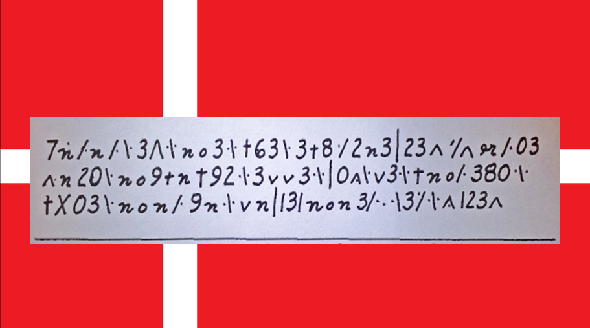Vor 50 Jahren fand man in einem dänischen Militärmuseum einen verschlüsselten Text, über dessen Hintergrund kaum etwas bekannt ist. Auch meine Leser konnten das “Kopenhagen-Kryptogramm” bisher nicht lösen. Gelingt es vielleicht jetzt?
English version (translated with DeepL)
Heute möchte ich zunächst einmal auf ein Video hinweisen. In diesem geht es um den verschlüsselten Brief aus dem Utah-Krieg (1858), über den ich Ende letzten Jahres gebloggt habe. Adam Sampson und Matthew Brown haben ihn damals gelöst.
Ken Alford, der mir den Brief zur Verfügung gestellt hat, hat bei der Utah State History Conference zusammen mit Bill MacKinnon einen Vortrag über diesen Brief gehalten. Im folgenden Video gibt es diese Präsentation zu sehen (ich werde ab 32:15 dankenswerterweise darin erwähnt):
Das Kopenhagen-Kryptogramm
Kommen wir zu einem anderen Thema. Irgendwann nach dem Zweiten Weltkrieg – vermutlich Ende der Fünfziger-Jahre – stieß ein Mitarbeiter eines Militärmuseums in Kopenhagen (Dänemark) auf einen Zettel, auf dem drei Zeilen notiert waren. Dieser Zettel befand sich auf der Rückseite eines Gemäldes aus dem Jahr 1835, das einen dänischen General zeigte. Die drei Zeilen waren verschlüsselt.
Im Militärmuseum konnte man mit dem Kryptogramm nichts anfangen. Daher schickte man es an die American Cryptogram Association (ACA), der weltweit wichtigsten Vereinigung von Hobby-Kryptologen. Dort fand allerdings niemand die Lösung. Mir ist leider nicht bekannt, welchen Aufwand man bei der ACA in die verschlüsselte Botschaft investiert hat. Insbesondere weiß ich nicht, ob bei der ACA jemand mit der dänischen Sprache vertraut ist.
2015 informierte mich Blog-Leser und ACA-Mitglied Kent Ramliden – ein Schwede, der in Florida lebt – über dieses Rätsel. Ich bezeichnete es als “Kopenhagen-Kryptogramm”. Hier ist es:
Leider ist so gut wie nichts über den Hintergrund des Kopenhagen-Kryptogramms bekannt. Die Nachricht muss nichts mit dem abgebildeten General zu tun haben (dessen Name ich leider auch nicht kenne). Vermutlich ist der Zettel deutlich jünger als das Bild, bei dem er gefunden wurde.
Die Schrift sieht für mich nicht besonders alt aus. Ich würde eher auf die Zeit nach dem Zweiten Weltkrieg tippen. Allerdings bin ich kein Schriftexperte.
Lösungsansätze
Ich habe bereits zweimal über das Kopenhagen-Kryptogramm gebloggt, und zwar in den Jahren 2015 und 2017. Es gab interessante Kommentare von meinen Lesern, die Lösung fand jedoch niemand.
Mehrere Leser bestätigten, dass es sich um eine einfache Buchstaben-Ersetzung handeln könnte – genau das, was man auf den ersten Blick erwarten würde. Die Zahl der unterschiedlichen Zeichen liegt bei 25, was diese Hypothese bestätigt.
Der lange senkrechte Strich, der dreimal vorkommt, könnte Sätze voneinander trennen. Demnach würde der Text aus vier Sätzen bestehen. Leider sind keine Leerzeichen zu erkennen.
Es fällt auf, dass im Text kaum Buchstaben-Doppelungen vorkommen. Vielleicht hat der Verfasser doppelte Buchstaben nur einfach geschrieben, oder es gibt ein Verdoppelungszeichen.
Am wahrscheinlichsten erscheint mir nach wie vor, dass der Text mit einer einfachen Buchstaben-Ersetzung verschlüsselt wurde. Vermutlich ist die Sprache Dänisch, doch sicher ist das nicht.
Es würde mich freuen, wenn meine Leser vier Jahre nach dem letzten Artikel dieses Kryptogramm noch einmal unter die Lupe nehmen würden. Ich gehe nach wie vor davon aus, dass es lösbar ist.
Follow @KlausSchmeh
Further reading: The Top 50 unsolved encrypted messages: 4. Kryptos
Linkedin: https://www.linkedin.com/groups/13501820
Facebook: https://www.facebook.com/groups/763282653806483/




Kommentare (13)